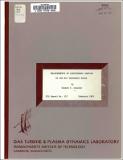| dc.contributor.author | Crawley, Edward F. | en_US |
| dc.contributor.other | Massachusetts Institute of Technology. Gas Turbine and Plasma Dynamics Laboratory | en_US |
| dc.date.accessioned | 2016-10-06T21:22:14Z | |
| dc.date.available | 2016-10-06T21:22:14Z | |
| dc.date.issued | 1981 | en_US |
| dc.identifier.uri | http://hdl.handle.net/1721.1/104728 | |
| dc.description | February 1981 | en_US |
| dc.description | Includes bibliographical references (page 80) | en_US |
| dc.description.abstract | A method has been developed and demonstrated for the direct measurement of aerodynamic forcing and aerodynamic damping of a transonic compressor. The method is based on the inverse solution of the structural dynamic equations of motion of the blade disk system in order to determine the forces acting on the system. The disturbing and damping forces acting on a given blade are determined if the equations of motion are expressed in individual blade coordinates. If the structural dynamic equations are transformed to multi blade coordinates, the damping can be measured for blade-disk modes, and related to a reduced frequency and inter blade phase angle. To measure the aerodynamic damping in this way, the free response to a known excitation is studied. This method of force determination was demonstrated using a specially instrumented version of the MIT Transonic Compressor run in the MIT Blowdown Compressor Test Facility. | en_US |
| dc.description.abstract | Unique on-rotor instrumentation included piezoelectric displacement transducers to monitor the displacement of each blade, three accelerometers to measure in plane motion of the disk and a leading edge mounted total pressure transducer. Resonance tests performed prior to installation of the rotor in the tunnel indicate that the blade disk structural interaction is dominated by the rigid body inertial coupling of the disk. An analytical model was developed for this inertial coupling. The model was verified by extensive testing of the tuned and severely mistuned rotor. No regions of aeroelastic instability were found while testing the rotor in the Blowdown Facility, but three forms of forced vibration were encountered. When operated in rotating stall, the blades were strongly excited at the fundamental frequency of stall cell excitation and those higher harmonics in proximity to blade resonances. | en_US |
| dc.description.abstract | At the fundamental frequency, the blade bending loading decreased as the blade entered the stall cell and increased as smooth flow was reestablished over the blade. In runs near the operating point, the rotor was aerodynamically excited by a controlled two-per-revolution fixed upstream disturbance. The disturbance was sharply terminated midway through the test and the ring down of the rotor monitored. Analysis of the data in terms of multiblade modes led to a direct measurement of aerodynamic damping for several interblade phase angles. During all runs, the third circumferential harmonic of the blade displacement was strongly excited by wakes shed from three evenly spaced upstream struts. The addition of a two per revolution fixed upstream disturbance caused a marked decrease in the third harmonic response, suggesting a nonlinear mechanism either in the upstream wake production or in the aerodynamic response of the rotor. | en_US |
| dc.description.abstract | It may therefore be possible to alleviate some forced vibrations by the deliberate introduction of upstream disturbances. | en_US |
| dc.description.sponsorship | NASA Lewis Research Center Grant NSG - 3079 | en_US |
| dc.format.extent | 122 pages | en_US |
| dc.publisher | Cambridge, Mass. : Gas Turbine & Plasma Dynamics Laboratory, Massachusetts Institute of Technology, [1981] | en_US |
| dc.relation.ispartofseries | GTL report #157 | en_US |
| dc.relation.ispartofseries | GT & PDL report ; no. 157 | en_US |
| dc.subject.lcc | TJ778.M41 G24 no.157 | en_US |
| dc.subject.lcsh | Compressors -- Aerodynamics | en_US |
| dc.subject.lcsh | Compressors -- Blades | en_US |
| dc.title | Measurements of aerodynamic damping on the MIT transonic rotor | en_US |
| dc.type | Technical Report | en_US |
| dc.identifier.oclc | 16246287 | en_US |
